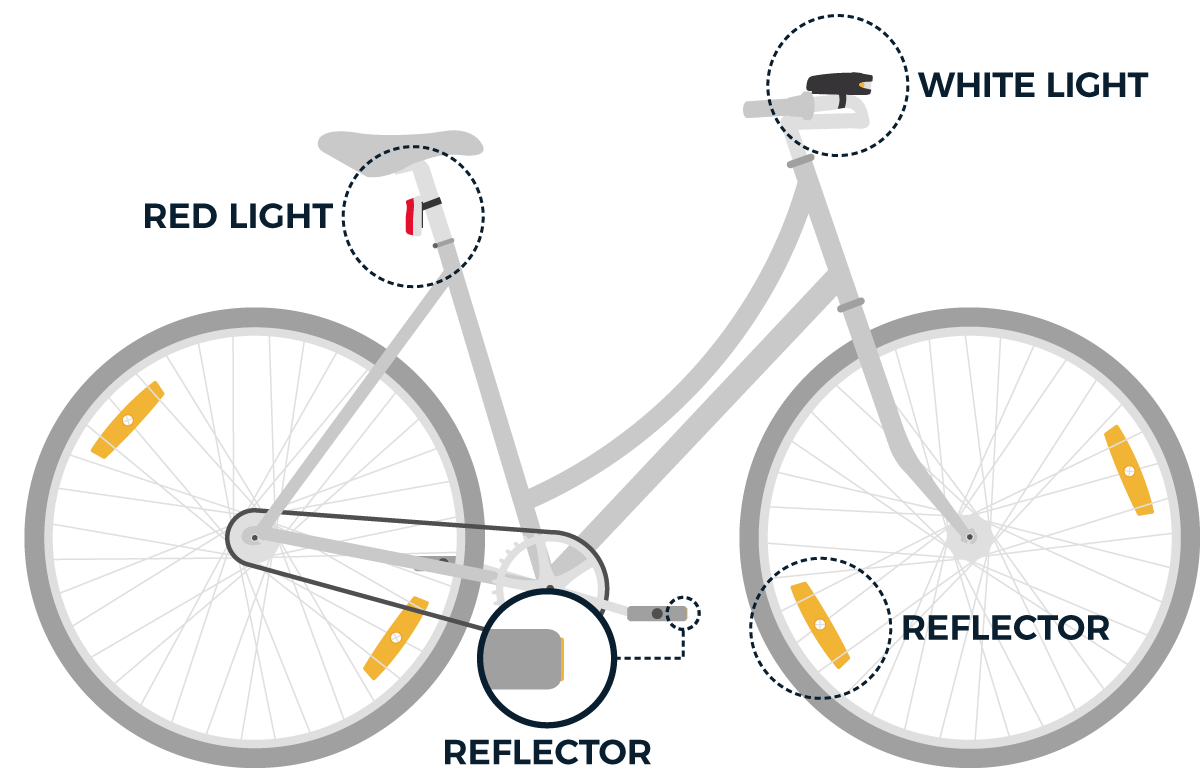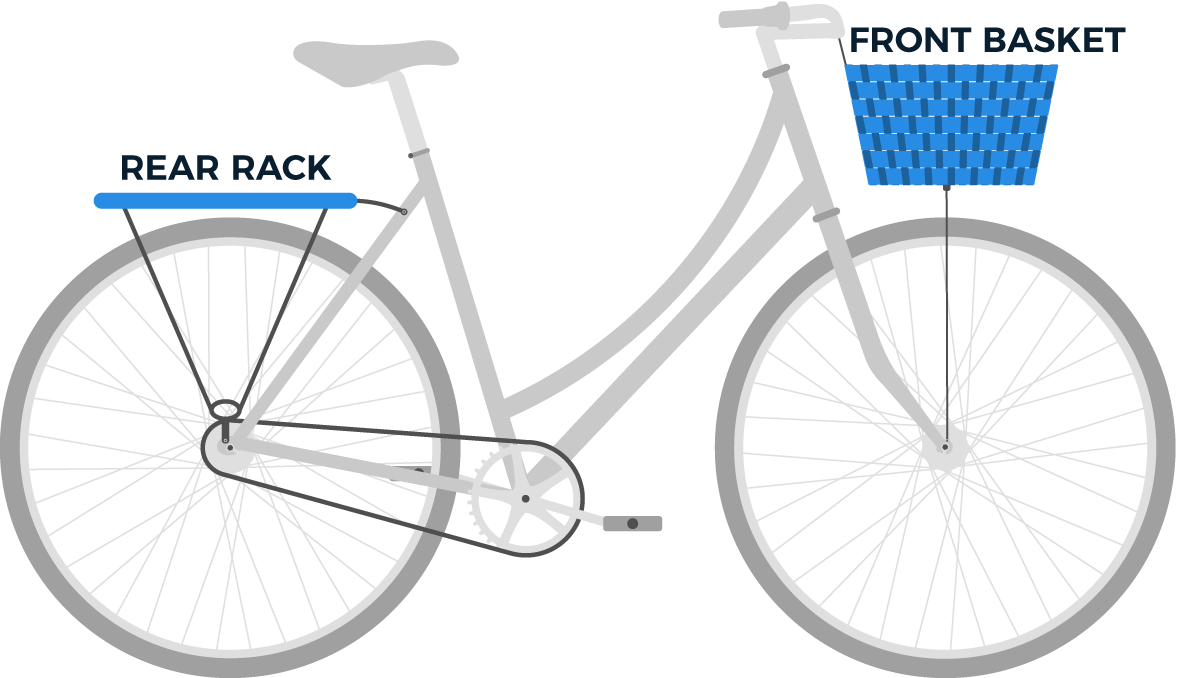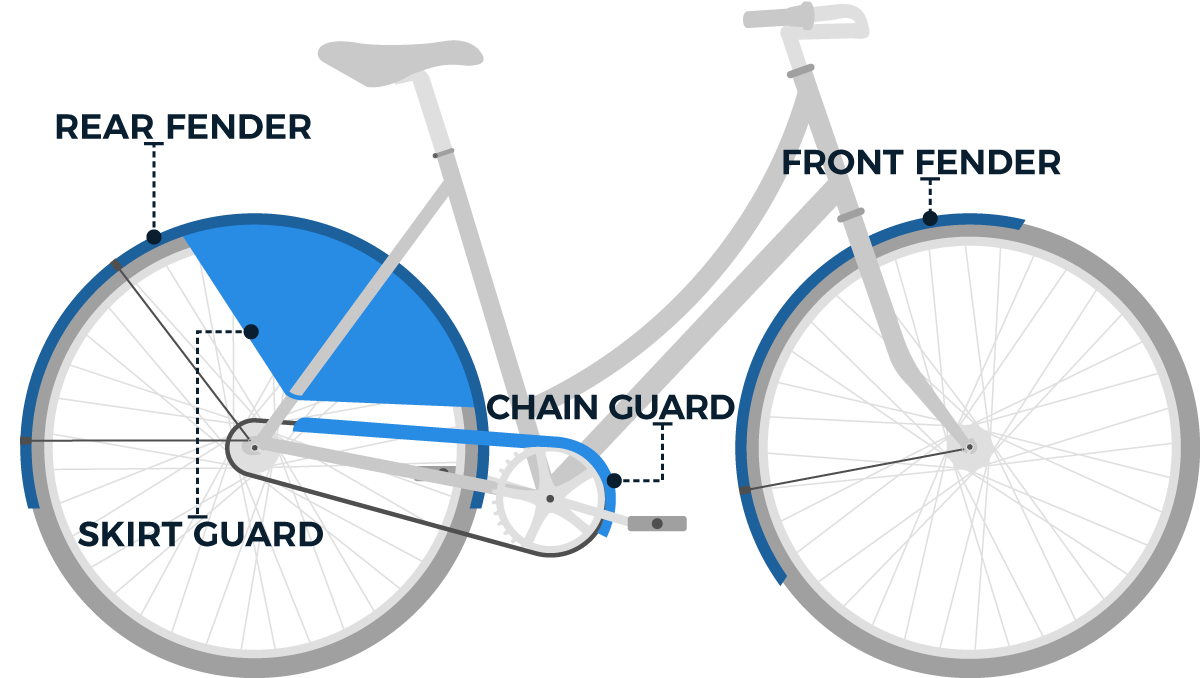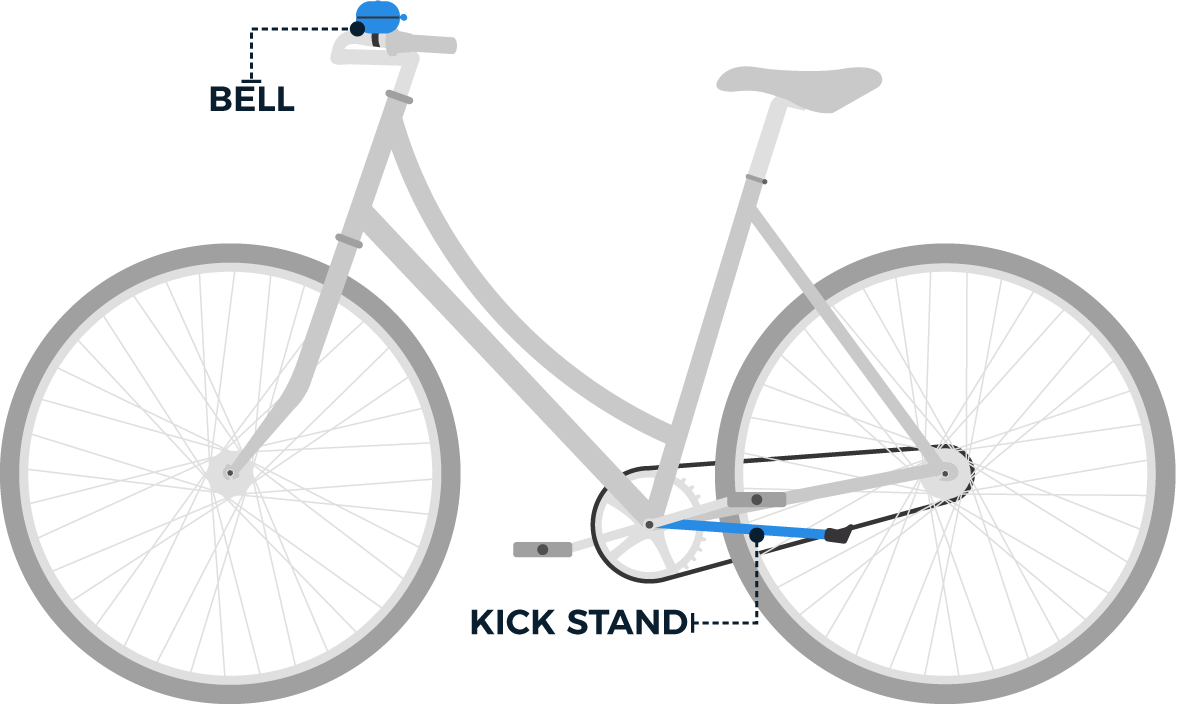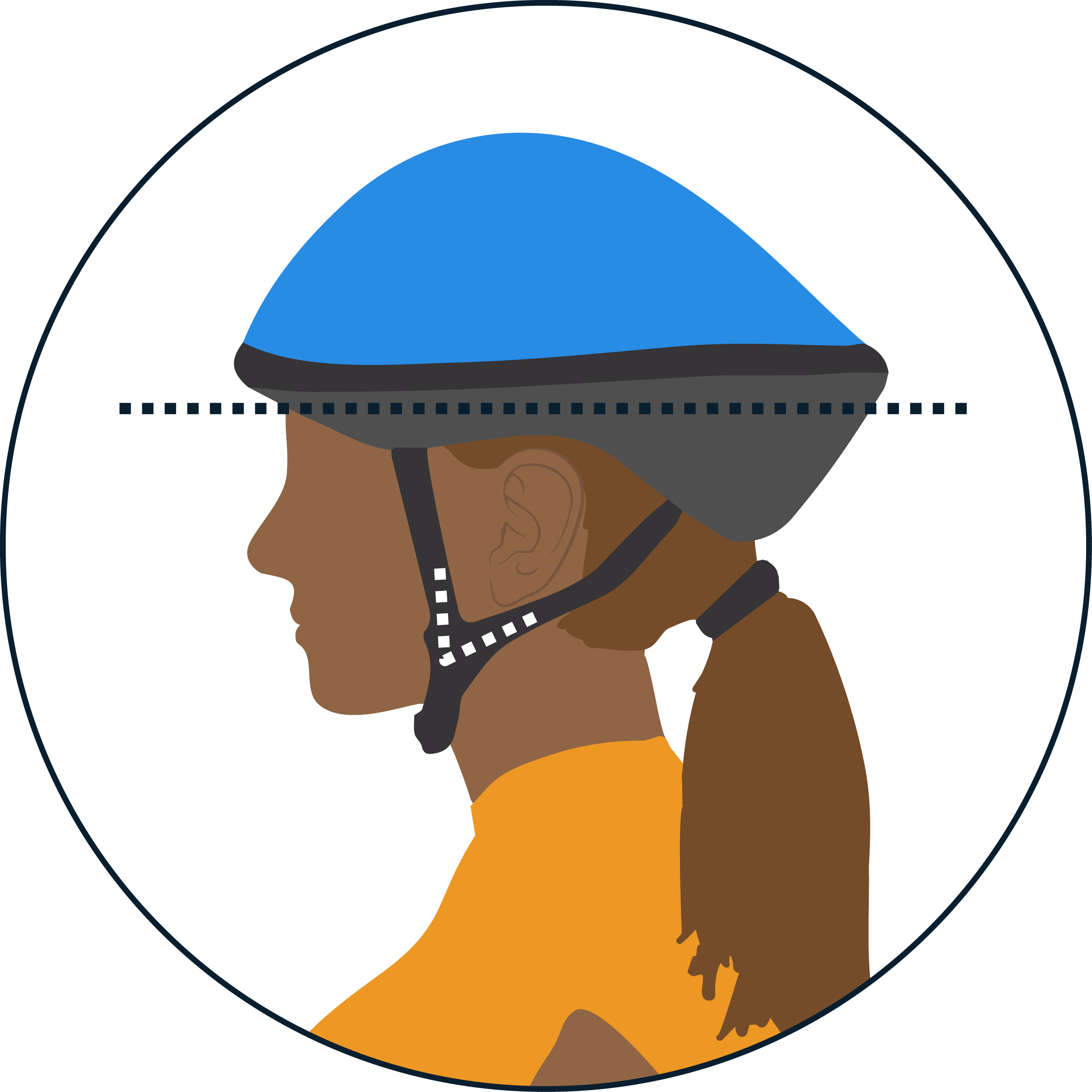Get Accessories
Having the right gear can make biking both safer and more enjoyable. We've provided information about some of the most common items that you might want to add to your bike, or get for yourself.
Your local bike shop should carry most of these items.
Accessorize your bike
As you get more comfortable on your bike, consider adding accessories so that it better fits your needs. You don’t have to buy everything at once.
Visit your local bike shop to find a wide variety of parts and components. For even more options, look online.
Get the basics
Use a U-lock as your primary lock. Cable locks should only be used as secondary locks to secure wheels.
Lights and reflectors help others see you at night. At a minimum, you should have:- a white light on the front of your bike
- a red light or reflector on the back of your bike
- reflectors, on either your pedals or ankles, that are visible from the front and back of your bicycle, and
- reflectors, on either your bike or your clothing, that are visible from the left and right sides of your bike
Most lights come with mounts that make it easy for you, or others, to remove them in a few seconds. Always take your lights with you.
Carry your belongings
A rack and bungee cords are a simple way to carry items on your bike. Increase your carrying capacity by adding a crate or basket to your rack. Keep your belongings in sight, put your rack or basket up front.
Panniers and other bike bags provide additional security and prevent your belongings from bouncing around. Waterproof bags also prevent your things from getting wet. Seat bags fit right under your saddle and are the perfect size for carrying basic repair tools.
Never hang bags, or anything else, from your handlebars. If you do, the item may become caught in your spokes and cause you to flip over.
Protect your clothing
Fenders rest above your tires and prevent water, mud, or other debris from splashing onto you.Skirt guards prevent fabric from getting caught in your rear wheel. They are especially helpful if you wear long skirts or jackets while biking.
Chain guards prevent your clothing from getting caught in the chain. Alternatively, you can roll up your pant leg, use a velcro strap to cinch your pant leg, or tuck the bottom of your skirt into the waistband.
Prepare for basic repairs
If you want to be able to make small repairs and adjustments on the go, consider carrying a patch kit, a spare tube, tire levers, a multi-tool, and/or a frame-mounted bike pump. These are especially important if you’ll be riding long distances or in areas without access to public transit.
Spruce up your bike even more
A bell provides an easy way for you to alert other people of your presence.A kickstand will allow you to stand your bike up without leaning it on something else.
Bike mirrors allow you to see what’s behind you without turning around. They can be installed on your handlebars or helmet.
Puncture-resistant tires help prevent flats. There are also other products that can help make any tire more durable.
Stickers and other decorations can help make your bike your own.
Outfit yourself
Everyday biking does not require any special clothing. Wear clothes that are comfortable and allow you to freely move your arms and legs. Avoid clothing that significantly restricts your movement, like pencil skirts and stiff jeans.
Be aware of the ways in which long or flowy clothing can become caught in your bike. Use a skirt guard to prevent long skirts or jackets from getting caught in the rear wheel. Prevent your pant leg from getting caught in your chain by rolling up your right pant leg, using a strap to tighten your pant leg around your ankle, or investing in a chain guard.
As the weather changes, you’ll need to make adjustments to your clothing. No matter what the season, it is wise to dress in layers so that you can add or remove layers.
Fit your helmet
You'll probably fall over once or twice, whether you're a new rider or an experienced one (we all have). A helmet can help protect your head. In Massachusetts, people who are 16 years old or younger must wear a helmet when biking. Most people riding in Boston, no matter their age, choose to wear a helmet.
Many inexpensive helmets are just as good as expensive ones. Just make sure your helmet meets the standards set by the Consumer Product Safety Commission. Be sure to replace your helmet after any crashes or when you see signs of damage.
Helmets only work if they are properly fitted. If you can, try on your helmet before you buy it. You don't want it to be so small that it sits on top of your head, or so large that there are big gaps between your head and the sides of the helmet. Once you've bought the right size, make sure it's on correctly:
- Wear your helmet low and level. Only two fingers should fit between your eyebrows and the brim of the helmet. When you look up, you should see your helmet. It should not tilt forward or backward.
- Adjust the straps to make a "v" underneath and just in front of your earlobes.
- Buckle the chin strap. Tighten it so it is snug but not too tight. You should be able to fit two fingers between the strap and your chin.
- Shake your head a bit. Your helmet shouldn't move around a lot. If your helmet has a slider or dial in the back, use it to make sure you have a snug fit.
Watch this video from FHWA on how to properly fit a helmet.
Check out resources from the Boston Public Health Commission on free helmets and fittings.
Cool days
Regardless of the season, remember that you will likely warm up during your ride. If you need a light jacket while walking around, just carry it with you during your ride.
Rainy days
A waterproof rain jacket, cape, poncho, and/or rain pants will help keep you dry. Remember, there’s a big difference between water-resistant and waterproof. Water-resistant products are ok if you don't mind being damp. Opt for waterproof products if you want to stay dry.
Cold days
Don’t overdress. Do wear layers. Biking will make you warm, so wearing a few mid-weight layers will help you control your temperature throughout your trip.
Protect your head. A lot of body heat is lost through your head. Get a thin, but warm, hat that fits under your helmet.
Protect your extremities. Gloves, a scarf or balaclava, and warm socks are essentials. Goggles or large glasses can help protect your eyes from cold wind.
Stay hydrated. Even in the winter, light exercise can lead to dehydration. Bring a water bottle or thermos so you can hydrate during your trip.
Hot days
Bring a bottle of water with you. Riding at a comfortable pace can prevent you from getting sweaty. If you sweat a lot, consider bringing a change of clothes.
Don’t overdress. If you’re hot before you start riding, you’ll be even hotter once you get going.
Arrive at your destination early to cool off. A washcloth, some baby wipes, and/or deodorant can be helpful if you need to freshen up but don’t have access to a shower.
Night-time
Light yourself up so that other people can see you at night. When riding at night you should always have:
- a white light on the front of your bike
- a red light or reflector on the back of your bike
- reflectors, on either your pedals or ankles, that are visible from the front and back of your bicycle, and
- reflectors, on either your bike or your clothing, that are visible from the left and right sides of your bike.
Other Boston by Bike sections
Boston by Bike
An overview of the Boston by Bike guide.
Choose a bike
We've provided information to help you find a bike that's right for you!
Get accessories
This is the current page.
Plan a route
We've provided information to help you figure out the best routes for bike trips. This includes info about taking your bike on the T.
Ride your bike
Here's what to do before each ride, how to ride on Boston's streets, and tips for riding in different weather conditions.
Park your bike
We've provided information on where you should and should not park your bike.
Fix your bike
Learn how to repair your bike or just get a tuned up.
Report a problem, learn the laws
We've summarized information about how to report a bike-related problem and included a summary of the Mass. General Laws about biking.
(Women) learn to ride
We spread the joys of biking and encourage more women and gender-nonconforming people to travel by bike.

